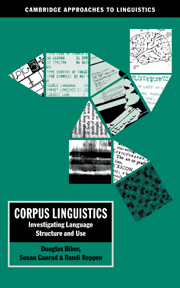Book contents
- Frontmatter
- Contents
- Preface
- 1 Introduction: goals and methods of the corpus-based approach
- Part I Investigating the use of language features
- Part II Investigating the characteristics of varietie
- Part III Summing up and looking ahead
- Part IV Methodology boxes
- Appendix: commercially available corpora and analytical tools
- References
- Index
1 - Introduction: goals and methods of the corpus-based approach
Published online by Cambridge University Press: 05 June 2012
- Frontmatter
- Contents
- Preface
- 1 Introduction: goals and methods of the corpus-based approach
- Part I Investigating the use of language features
- Part II Investigating the characteristics of varietie
- Part III Summing up and looking ahead
- Part IV Methodology boxes
- Appendix: commercially available corpora and analytical tools
- References
- Index
Summary
Studying language: structure and use
Studies of language can be divided into two main areas: studies of structure and studies of use. Traditionally, linguistic analyses have emphasized structure – identifying the structural units and classes of a language (e.g., morphemes, words, phrases, grammatical classes) and describing how smaller units can be combined to form larger grammatical units (e.g., how words can be combined to form phrases, phrases can be combined to form clauses, etc.).
A different perspective – which is the focus of this book – is to emphasize language use. From this perspective, we can investigate how speakers and writers exploit the resources of their language. Rather than looking at what is theoretically possible in a language, we study the actual language used in naturally occurring texts.
Many studies of language use focus on a particular linguistic structure, investigating the ways in which seemingly similar structures occur in different contexts and serve different functions. For example, in English that-verb-complement clauses and to-verb-complement clauses are similar in their structural characteristics and can be similar in meaning, as in sentences such as:
(1) I hope that I can go.
(2) I hope to go.
In addition, that-clauses can occur with the that omitted:
(3) I hope I can go.
A structural analysis would describe the grammatical similarities and differences among these three sentences. All three options are equally grammatical ways to complete the meaning of the verb. However, an analysis of language use goes beyond traditional grammatical description to ask why the language should have multiple structures that are so similar in their meaning and grammatical function.
- Type
- Chapter
- Information
- Corpus LinguisticsInvestigating Language Structure and Use, pp. 1 - 18Publisher: Cambridge University PressPrint publication year: 1998

